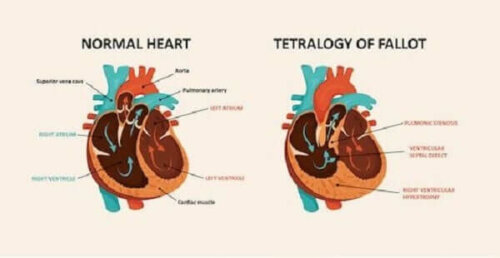What’s Tetralogy of Fallot?

Tetralogy of Fallot is a fairly common congenital heart disease. It requires early intervention so that it doesn’t affect the patient’s life. In this article, you’ll discover its symptoms, complications, and treatment options.
As the article Tetralogía de Fallot en el paciente adulto: a propósito de un caso (In English: Tetralogy of Fallot in adult patients: a case study) points out. This disease constitutes 10% of all congenital heart diseases. It requires early intervention, as it can cause serious complications and affect the patient’s quality of life.
Tetralogy of Fallot
This condition causes infundibular pulmonary stenosis (IPS), as the article Tetralogy of Fallot: Case report and literature review points out. In other words, the muscle under the valve is thicker and causes a narrowing at the outlet of the right ventricle.
Likewise, this congenital cardiopathy can also cause overriding aorta. This means that the aorta is positioned on the ventricular septal defect (VSD), which prevents it from working properly.

Likewise, another characteristic of tetralogy of Fallot is that it can cause right ventricular hypertrophy (RVH). The heart muscle thickens, meaning it must work harder to contract due to the narrowing of the ventricular outflow tract.
Symptomatology
The reason why tetralogy of Fallot should be operated on as soon as possible is because its symptoms are severe. In fact, below, we’re going to explain some points that will allow you to better understand how it affects the quality of life of younger patients:
- Cyanosis. Bluish discoloration of the body and the visible mucous membranes that indicates that there’s poor blood oxygenation. It can appear on the face, hands, or anywhere else on the body, and also in the mouth (perioral cyanosis).
- Diaphoresis. Sweating that occurs when the baby is breastfed because it requires a great effort and it’s difficult for them to breathe (dyspnea).
- Acrocyanosis. The fingers and toes are cold most of the time. They present cyanosis and diaphoresis.
Children can also have a heart murmur. Likewise, developmental delay, the presence of fatigue after minimal physical exercise, and even fainting can alert to the presence of this congenital heart disease.
This article may interest you: 7 Heart Murmur Symptoms You Should Know!
Complications this condition causes

It’s important to raise awareness about the need to treat tetralogy of Fallot as soon as possible. In fact, all children with this heart disease must undergo corrective surgery.
In fact, if left untreated, this disease can lead to death at an early age. It can also lead to disabilities in adulthood. In addition, failure to treat this congenital heart disease can lead to infections. For example, the inflammation of a heart valve due to a bacterial infection.
You should also read: Recognize the Symptoms of a Heart Attack
Living with tetralogy of Fallot
A person who undergoes surgery to treat tetralogy of Fallot will soon be able to lead a normal life. However, they’ll need lifelong medical monitoring due to certain risks.
People who’ve been treated for this congenital heart disease are at risk of sudden death after the age of 35. Nevertheless, the percentage is very low. Also, arrhythmias can increase over the years.
Pregnant women with this pathology must undergo certain tests that assess their health, the arrhythmias they have, and the measures they must adopt (absolute rest, no harmful habits such as smoking, and maintaining a healthy weight, among others).
As you’ve seen, being born with tetralogy of Fallot can condition the rest of a person’s life. However, with early corrective surgery and medical follow-up, the patient can lead a normal life.
We hope that this article allowed you to learn more about a type of heart disease you may not have heard about before. This will help you take the necessary measures if someone you know suffers from it at some point.
All cited sources were thoroughly reviewed by our team to ensure their quality, reliability, currency, and validity. The bibliography of this article was considered reliable and of academic or scientific accuracy.
- Alva Espinosa, Carlos. (2013). Tetralogía de Fallot: Actualización del diagnóstico y tratamiento. Revista mexicana de cardiología, 24(2), 87-93. Recuperado en 31 de marzo de 2019, de http://www.scielo.org.mx/scielo.php?script=sci_arttext&pid=S0188-21982013000200004&lng=es&tlng=es.
- Herranz Jordán, B.. (2009). Control de los niños con cardiopatía congénita en Atención Primaria. Pediatría Atención Primaria, 11(44), 639-655. Recuperado en 31 de marzo de 2019, de http://scielo.isciii.es/scielo.php?script=sci_arttext&pid=S1139-76322009000500011&lng=es&tlng=es.
- Pinzón, A. (2016). Central and peripheral cianosis. Acta Medica Colombiana, 41(4), 274-274.
This text is provided for informational purposes only and does not replace consultation with a professional. If in doubt, consult your specialist.








